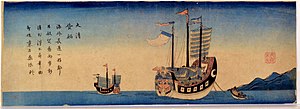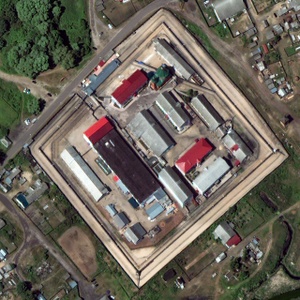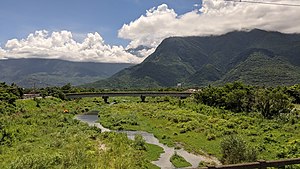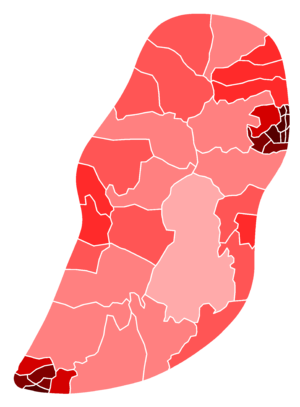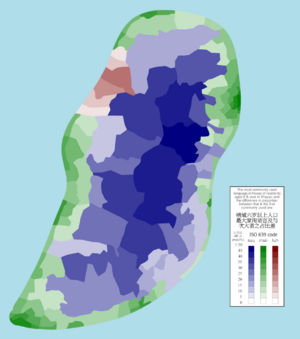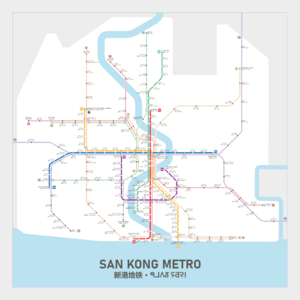Shaoyu
Free State of Shaoyu Shàoyù zìyóu zhōu (Pinyin) | |
|---|---|
| Motto(s): 哨域万歳! "Long Live Shaoyu" | |
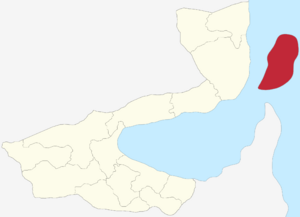 Map of Monsilva with Shaoyu highlighted | |
| Country | |
| Free state status | 27 January 2024 |
| Capital | San Kong (新港) |
| Government | |
| • Body | Shaoyu State Government |
| • Premier | Feinuo Ziming (SLP) |
| • Deputy Premier | Qin Huiqing (SDP) |
| Population (2024 estimate) | |
| • Total | 8,000,000 |
| Time zone | TMB+11:00 (Monsilvan Eastern Time, MET) |
| ISO 3166 code | MS-SHA |
| GRP (¥) | ¥1.53 trillion |
| Major airports | San Kong International Airport (SKG) Yingjiang City Airport (YJC) |
| Transit System(s) | MRA San Kong Metro |
| Police[1] | Shaoyu State Police |
| Ambulance[2] | Shaoyu State Ambulance |
| Fire[3] | Shaoyu Fire Service |
Shaoyu, officially the Free State of Shaoyu (Monsilvan: 哨域自由州; pinyin: Shàoyù zìyóu zhōu; Shaoyunese: 哨域自由州; ibiji: Shōyoku jiyū shū), is a free state of the Monsilvan Republic. The state has around 8 million people, with approximately 47% of the state's population living in its capital, San Kong. Shaoyu is Monsilva's only insular state, located on its namesake island several hundred kilometres off the coast of the state of Meixian on mainland Monsilva. Shaoyu has a characteristic geography often referred to as 'the cone' as its coastal areas are flat and gradually slope up into tall mountains that lie in the center of the island. Shaoyu is Monsilva's only state with the 'free state' designation. This designation gives the state's government the ability to reject legislation from the federal government (in most cases), while other states, although they have significant autonomy and are able to override many federal legislations, are unable to outright reject any legislations. The reason for Shaoyu's increased autonomy is not only due to having been founded in 2024, 41 years after most other states were founded, but also due to its culturally unique and independent history from Monsilva from the mid 19th century until they re-united in early 2024. Shaoyu is governed by the Shaoyu State Government, with Feinuo Ziming of the Shaoyu Liberation Party being the current premier. The state is divided into 41 counties, 56 legislative constituencies and 174 municipalities and is represented by 10 Senators in the Senate and 56 members of the Legislative Assembly. The Shaoyu State Parliament consists of 174 seats, and is currently lead by the Shaoyu Liberation Party and the Democratic Coalition, with the Conservative Party of Shaoyu and the Nationalist Coalition leading the opposition.
Shaoyu is Monsilva's second most populous state and has the second highest urbanization of all the states, with 82% of the population living in urban areas. Shaoyu's economy is very equally balanced between manufacturing, finance and agriculture. Cities, such as San Kong and Yinjiang are predominantly focused on maritime trade and manufacturing, while towns and villages located more inland in the island are focused on agriculture producing crops and livestock. Industry in Shaoyu was severely damaged by the genocide which lasted from 1969 to 2023 and the OU military intervention in 2023. However, the state has been recovering quickly and experts have predicted that with support from the large Monsilvan economy, regions of the state should sit amongst the top five richest regions of the country by 2030. Shaoyu has 10 cities, with the largest being San Kong, followed by Huiyong and Yinjiang and the smallest being the Rongmei Honorary City. Shaoyu has a nominal GRP of around ₵253 billion, giving it a GRP per capita of ₵31,672.
Settlements in Shaoyu are connected together by the Monsilvan Railways Administration, which took over the old railway infrastructure in 2024 with the intent on improving it to the standards of the rest of the country. Ferry services running between Yinjiang and Menchi began operating in November 2023, and a high-speed rail line from Yinjiang to Gumiao via Huiyong and San Kong began operating in December 2023, although at a reduced speed compared to other high speed rail routes in Monsilva. San Kong is also served by the San Kong Metro which was built during the Jackian administration of Niao Dao in the 1950s and 60s. Shaoyu has two major international airports: San Kong International Airport, Huiyong International Airport and Yinjiang City Airport.
Contents
Toponymy
The earliest confirmed name to have been given to the island was "Jitgoân" by Ding Shi, a Zhong dynasty scholar. He acquired this name after asking the Shaoyunese people what they named the island, however in his book Kwaguo Shui (258 CE), he expressed his confusion when they wrote the name down in Shaoyunese as "日源" which to him would be pronounced like "Nyiknan". This was, in turn, also one of the earliest discoveries of the differences between the Shaoyunese and Monsilvan languages. The name "Jitgoân" remained the most common name in literature dating from Ding's book until the 12th century, when the character "哨" (shào) began to become a more common name for the island, popularized during the height of the Luhk dynasty. It was after the Zhou invasion of Shaoyu in 1234 that the name Shaoyu (哨域) first appeared. "域" means "region" or "territory", this was added on to the island's name as it had become a territory of the Zhou dynasty. Shaoyu became the most common name for the island soon after the invasion. This also carried over to Shaoyunese itself, which continued to use the characters "哨域", but pronounced them the Shaoyunese way, as Samwi.
Other names that have been given to Shaoyu after the name developed include Niao Dao (from 鸟岛; Niǎo dǎo) which is Monsilvan for "bird island" and was used during the Jackian administration of the island from 1828 to 1969. The name Akvatika was also created, which comes directly from the Slavic "Акватика". The name Akvatika is a translation of Aquatica a genus of fireflies native to Shaoyu.
History
Early history
The island of Shaoyu has been inhabited for over two thousand years, with the earliest archaeological evidence dating to around 400 BCE. The first recorded contact between inhabitants of the island and mainland Monsilvans was in the early 1st century CE between the Zhong dynasty, which inhabited the area now known as the states of Meixian, Leibo and Luhai. After meeting, the two peoples chose to trade with each other, with the Zhong dynasty providing Shaoyunese villagers with mainland crops and other materials that couldn't be found on Shaoyu, while the Shaoyunese would predominantly provide fish and other marine animals they caught from the east coast of the island in the Kivu Ocean which didn't frequently visit the shores of the mainland. This trade continued between the island and the Zhong dynasty's successors until 1201, when the Zhou dynasty took over all the Monsilvan dynasties. The Zhou dynasty was not fond of the agreement and the government wished to annex Shaoyu and make the island part of its dynasty. In 1233, the Zhou dynasty sent several ships over to the island and invaded it. It took four months of skirmishes before the Zhou dynasty managed to take over the entire island and all settlements had surrendered. This began the first Monsilvan administration of Shaoyu, which lasted for 180 years until 1414.
Administration of the Beining Heavenly Kingdom
In 1414, the Beining Heavenly Kingdom was formed as a breakaway state from the Zhou dynasty. The kingdom encompassed all of modern day Meixian, Leibo and Luhai as well as Shaoyu island, despite the island's residents showing dislike towards the new kingdom's leaders by frequently attacking government officials and tax collectors that would visit the Shaoyunese villages. In order to appease the Shaoyunese people, the King of Beining's son married the daughter of an influential Shaoyunese noble. In 1420, they had a son who was granted the title 'Prince of Shaoyu'. For the next 80 years, there were fewer signs of rebellion on Shaoyu against the Beining government, however this changed in 1497, when the second Prince of Shaoyu died and his son took the title. The new Prince of Shaoyu was a strong advocate for Shaoyunese independence from the Beining Heavenly Kingdom, so in 1500, the Prince declared himself King of Shaoyu and created the Kingdom of Shaoyu. The Kingdom was unrecognized by both the Beining Heavenly Kingdom and the Zhou dynasty, both of which laid claim to the island. However, the Beining Heavenly Kingdom did not choose to fight the new kingdom as the Shaoyunese navy was more powerful and demonstrated more loyalty than their own, which was predominantly made of paid mercenaries.
In 1568, the Zhou dynasty ceded itself to the Empire of Baltanla, who subsequently invaded and deposed the government of the Beining Heavenly Kingdom, establishing the Principality of the Shan. The Empire did not invade Shaoyu however, as the Emperor respected their highly skilled, although small, navy. Instead they gave the King of Shaoyu a choice of either invasion and giving up the island, or allowing the Empire to establish a client state on the island, which would allow the King and his family to remain soverign, while the empire would appoint the island's government. The King of Shaoyu chose the latter option, as he knew war would result in an inevitable and harmful loss for the island and its people. This established the Commonwealth of Shaoyu, which lasted until 1731.
Administration of the Great Shan

In 1730, the Principality of the Shan seceded from the Empire of Baltanla to form the Kingdom of Great Shan. This exit also lead to the Commonwealth of Shaoyu losing its client state status, which ended the Baltanese government on the island but also removed the empire's protection. This sudden change left the Shaoyunese government extremely weak with almost no authority over its own people. This meant, that in March 1731, when the Great Shan invaded Shaoyu, the island could barely defend itself. The invasion lasted only six months, with the harsh summer storms likely being the only reason for the Shan Navy's difficulty.
The re-establishment of mainland administration of Shaoyu was mostly welcomed, as the island had struggled economically in the last few years of the empire, while the mainland was doing much better. This new, richer, administration allowed Shaoyu to catch up to the mainland and become prosperous. It was during the next one hundred years until the Monsilvan Civil War that Shaoyu developed a reputation of being an important region in the kingdom and being considered an integral part of Monsilva, with cultural and linguistic similarities becoming more clear and the islanders' identities becoming that of Monsilvans (or Shan people as they were known at the time) rather than independent Shaoyunese.
Government rebellion became increasingly common during the 1810s and 1820s as the Shan began increasing tax on workers and famines began starting in various regions across the country. These events lead to the beginning of the democracy movement in the 1820s, and eventually began the Liberate Monsilva Movement, who began the Monsilvan Civil War in June 1824. The movement started in northern Monsilva, and included the island of Shaoyu. However, four years into the war in 1828, the Jackian navy landed on the eastern coast of Shaoyu and offered to provide the Liberate Monsilva Movement with plenty of money, which it was quickly running out of in the war, in exchange for Jackson annexing the island of Shaoyu. The provisional government accepted, and Niao Dao was created.
Jackian administration of Niao Dao
The Jackian administration of Shaoyu, officially known as the Jackian Administrative State of Niao Dao, was initially very unpopular amongst the islanders. However, the administration quickly grew in popularity as it provided unprecedented economic growth for the island, becoming richer than any region in mainland Monsilva by the late 19th century. The Kingdom of Monsilva, which had been established at the end of the civil war after the eventual success of the Liberate Monsilva Movement, seeing the success of Niao Dao, began to develop strong ties with the administrative government of Niao Dao, as well as the government of Jackson. By the 1920s, Jackson had become one of Monsilva's closest allies.
These close diplomatic relations began deteriorating in the 1960s however after the establishment of martial law by the new prime minister of Monsilva, Shao Yaoting. Shao began directing Monsilva into right-wing authoritarianism and strongly opposed Jackson's administration of Niao Dao and dispised their liberal democratic systems. In 1968, the 140-year lease that had been signed between Monsilva and Jackson over Shaoyu came to an end, but the Niao Dao government and its people strongly opposed returning Niao Dao to Monsilva's authoritarian government. In early 1969, the Zloveshchiyan government approached Jackson with a proposal for them to take over the administration of the island instead. Specific details, including whether or not the agreement stated for Zloveshchiy to hand the island back to Monsilva after a period of time, are still unknown. On 21 October 1969, Jackson officially handed the administration of Niao Dao over to the Zloveshchiyan government, who subsequently named the island "Akvatika".
Zloveshchiyan administration of Akvatika
The Zloveshchiyan administration was ironically a very authoritarian one. Contact between the island and most of the outside world was limited, and although most of the island's infrastructure was maintained, it was clear through foreign surveillance missions that large portions of the island's cities became abandoned. As discovered in August 2023, the Zloveshchiyan administration was responsible for murdering and oppressing around 4 million people on the island over the course of 54 years from 1969 to 2023 in the Akvatika Island genocide.
Monsilva never officially recognized the Zloveshchiyan administration of the island, even after the establishment of the Monsilvan Republic in 1978. However, the government of Monsilva never went beyond denouncing the administration on occasion throughout the rest of the 20th century and in the first decade of the 21st century. It wasn't until 2014 when Monsilva joined the Global ACES program that the Zloveshchiyan administration became a frequent topic of discussion amongst Monsilvans and Monsilvan politicians.
In 2023, after a federal election, a new prime minister, Lin Yao-tang was elected. Lin was the first prime minister to put any legislation associated with Shaoyu on their manifesto. In late June 2023, Lin and his government officially announced that Monsilva was recognizing Shaoyu Island as Monsilvan territory. This announcement was soon followed up with support from many of Monsilva's allies around Terraconserva, including the Jackian government which announced that the deal between Jackson and Zloveshchiy in 1969 has been struck as null and void. On 23 August, the Akvatika Island genocide was discovered, and although many theories had been previously made about it, this was the first discovery of proven evidence that people were being systematically killed by the Zloveshchiyan administration on the island. This discovery was followed up by the Ostlandet Union voting to recognize the island as Monsilvan territory as well, and giving the government of Zloveshchiy an ultimatum to either relinquish control of the island to Monsilva or face ejection.
Return of Monsilvan administration
On 30 August 2023, after a rejection of the ultimatum by the Zloveshchiyan government, who stated that "the OU has no power to make these decisions", the OU military intervention in Akvatika began. The intervention lasted one month until 30 September 2023, when the final Zloveshchiyan troops surrendered in the island's southern city of Yinjiang. The OU Task Force for Shaoyu subsequently established the OU mandate for Shaoyu which administrated the island for the next few months in order to prepare it for the transition to Monsilvan administration.
On 27 January 2024, the OU mandate for Shaoyu was dissolved and Monsilva began its administration of Shaoyu. Several administrative bodies, including the Shaoyu State Government had already been created during the mandate, but only after this date did they become the executive body of the island.
Administration
Local government
The state of Shaoyu is governed by the Shaoyu State Parliament, which is based in the Shaoyu State Office in San Kong. The state parliament is a unicameral legislature which consists of 174 seats. Each municipality in Shaoyu is represented by one State Parliament Member. Members are elected for four-year terms, where they can seek re-election or resign and have a successor be elected during the state elections. The Parliament meets every week, with the day depending on the first weekday after the state election which takes place in different states at different times. The leading party in the State Parliament determines who will be the Premier. Feinuo Ziming of the Shaoyu Liberation Party is the current Premier of Shaoyu.
The Shaoyu State Government is considered the most powerful state government in Monsilva. This is due to it governing Monsilva's only free state. This free state status grants extra powers to Shaoyu that Monsilva's fourteen other states don't have. The most significant characteristic of a free state, is their ability to overrule most federal legislations. In other states, if the federal government passes a legislation, all states must follow. They are able to amend to the legislation but they are unable to revoke or or remove elements from it. Shaoyu, however, is able to remove elements and revoke almost any federal legislations passed. According to the Monsilvan government, the reason the decision to declare Shaoyu as a free state was made is due to the island's inherant independence from mainland Monsilva, having been a seperate entity since 1828 when it was handed over to Jackson.
National government
Shaoyu is represented in the Parliament of Monsilva by 10 senators in the Senate and 56 MLAs in the Legislative Assembly. This means Shaoyu's seats make up 11.7% of the Senate and 10.9% of the Legislative Assembly.
Geography
Shaoyu's physical geography is commonly referred to as 'conical'. This nickname is thanks to Shaoyu's mountains, which lay in the very center of the island and slope downwards towards the coastal areas, which consist of flat fields and forests. Despite the mountains taking up almost 50% of the island, Shaoyu has a surprising amount of very liveable and arable land. This has allowed Shaoyu to develop a large population over many years, with it peaking in the 1960s at almost 17 million people.
In contrast to its liveability, hindrances include somewhat frequent earthquakes and flooding during storms in the late summer and autumn. This has caused serious damage to infrastructure and resulted in noticeable losses of life on the island in the past, however in recent years countermeasures, including the EEWS have significantly decreased damage, injuries and deaths resulting from natural disasters.
Climate
On the east coast, Shaoyu is relatively warm all year, getting particularly hot during the summer with peaks of around 32 degrees Celsius and getting as cold as 5 degrees Celsius at the peak of winter. During the summer and autumn Shaoyu's east coast experiences a lot of rainfall and winds from storms forming over the Kivu Ocean. Shaoyu's west coast is different, as the mountains dividing the island in the middle cause the temperature to be slightly cooler, with some years allowing negative temperatures to be recorded in the foothills.
In the mountains of Shaoyu, it is far cooler and drier thanks to the altitude. However, snowfall anywhere but the tallest peaks is still relatively rare.
Cities
Shaoyu has ten cities. While there are more urban conglomerations than what is listed below, they have not been formally declared as cities and therefore are not included. Rongmei, despite not meeting the usual population requirements to be a city, is included as an honorary city, a status previously given to two cities in Weishi.
| Name | Monsilvan | Population |
|---|---|---|
| San Kong | 新港市 | 3,763,405 |
| Huiyong | 汇永市 | 925,696 |
| Yinjiang | 印江市 | 844,717 |
| Gumiao | 古庙市 | 221,446 |
| Yuzhen | 玉珍市 | 217,670 |
| Kuodian | 阔典市 | 195,812 |
| Siumei | 燒味市 | 173,993 |
| Chaonan | 潮南市 | 99,968 |
| Yamfong | 任房市 | 80,941 |
| Rongmei | 容美荣誉市 | 68,180 |
Demography
| Country of origin | Population | Percent | |
|---|---|---|---|
| 6,968,000 | 87.1 | ||
| 408,000 | 5.1 | ||
| Non-Monsilvan | 624,000 | 7.8 | |
| 401,000 | 5.0 | ||
| 78,000 | 1.0 | ||
| Others | 145,000 | 1.8 | |
| Total | 8,000,000 | 100.0 | |
A 2023 census recorded that 624,000 people, or 7.8% of Shaoyu's population declared they were neither Monsilvan or Shaoyunese. The table shows the most common countries of claimed origin of Shaoyu residents. Shaoyu's mostly closed off condition for forty years before 2023 has resulted in relatively few people claiming they are not from Monsilva, Shaoyu or Zloveshchiy. 82% of Shaoyu's population live in of Shaoyu's 10 cities. This is also where the vast majority of Shaoyu's non-native population lives.
Religion
Shaoyu is a predominantly secular state, having been under a communist ideology from the 1970s until the 2020s. Around 41.8% of Shaoyu's population claim they are not affiliated with any religion, while in second place, 36.3% of the population claimed they were Christian. Next in the category were Monsilvan folk religion, with 17.6% of the population claiming to be followers, and the final option of Buddhism saw 4.3% of the population claiming to be followers.
Religious composition in Shaoyu according to 2023 Census
Language
Shaoyu is one of Monsilva's most linguistically diverse regions. The state has three official languages, Shaoyunese, Monsilvan and Luhainese, as well as two further minority recognized languages: Slavic and Jackian. Monsilvan is the most spoken language on the island, with many people living in urban areas of the state being unable to speak any other language, including Shaoyunese. Monsilvan is considered the lingua franca of Shaoyu, as Monsilvan is still common amongst people living in urban areas and on the west coast of the island. Most Shaoyunese speakers can also speak Monsilvan, while the opposite is much less common. In rural areas, the dominant language is Shaoyunese. Although rarely spoken in the rest of the island, Luhainese is the most commonly spoken language in Sin Ming County in north-west Shaoyu. The language was brought over by a large influx of people from Luhai during the 1960s when Shaoyu was known as Niao Dao. Over time, it has become culturally significant in the area, and so the language has maintained a noticeable presence.
The two minority languages, both of which are not native to the island, are thanks to the two previous administrations of Shaoyu before 2024. In 1828, Jackian was adopted as an official language of Jackson's Administrative State of Niao Dao. Although very few people on the island could speak Jackian at the time, it gradually became more and more common as travellers from Jackson and the rest of Ecros would come to Niao Dao able to speak Jackian, but not Shaoyunese or Monsilvan. In 1966, towards the end of the 140 years that Jackson administered Shaoyu Island, almost 70% of the population of Niao Dao could speak enough Jackian to hold a conversation. Slavic was not a common language on the island until it was brought there by Zloveshchiyan officials after Zloveshchiy took control over the island in 1969. It is theorized that through the 1970s, 80s and 90s, many people were forced to learn Slavic in education centers, however this remains unproven. As of 2024, the majority of fluent speakers of Slavic are Zloveshchiyans who live on the island, but there is also a sizeable minority of Shaoyunese people, most of which were freed from labor camps during the OU intervention.
Around 76% of the population of Shaoyu speaks more than one language. The most spoken second language is Monsilvan, while the most spoken non-native language is Quebecshirite.
| Language | L1 Speakers | L2+ Speakers | ||
|---|---|---|---|---|
| Absolute | Per cent | Absolute | ||
| Monsilvan | 4,351,706 | 54.4% | 2,762,607 | |
| Shaoyunese | 2,803,576 | 35.0% | 2,257,667 | |
| Slavic | 389,042 | 4.9% | 221,319 | |
| Luhainese | 218,001 | 2.7% | 173,806 | |
| Jackian | 174,422 | 2.2% | 42,328 | |
| Other | 63.254 | 0.8% | 1,182,351[4] | |
| Total | 8,000,000 | 100.0% | 6,440,078 | |
Transport
Transport in Shaoyu is administered by the Shaoyu State Department for Transport. Public transportation in Shaoyu had one of the largest budgets of any industry during the Jackian administration of Niao Dao on the island. During the 1950s and 1960s, several airports, including San Kong International Airport, were constructed, as well as an extensive state-wide railway network with high-speed capabilities introduced in 1966 (maximum speeds of around 210km/h). The San Kong Metro was also built during Niao Dao from the 1920s with the last extension being added in 1968.
During the Zloveshchiyan administration of Akvatika, funding for public transport declined massively and many of Shaoyu's railways were abandoned or repurposed for industrial usage. High-speed services were stopped in 1977 with the rail being used for standard speed commercial services instead. Many of the islands airports were taken over by the military or repurposed into labor camps during the Akvatika Island genocide. Although large portions of Shaoyu's transport infrastructure was left in disrepair, very little was actively demolished from the era of Niao Dao.
After the OU military intervention in Akvatika ended in September 2023 and the OU mandate for Shaoyu was formed, recovery of transport infrastructure was part of the agenda of the newly created Shaoyu State Government. In December 2023, many of Shaoyu's former railway services were restored, including the high-speed services. However, due to the out-of-date tracks, these high-speed services are considerably slower than most of Monsilva's existing high-speed services. Refurbishment of most of the San Kong Metro began in January 2024 and is expected to finish by the end of 2025.
Aviation
Shaoyu has multiple international and domestic airports. The largest of which include San Kong International, Huiyong International and Yinjiang City. In the 1960s, San Kong International Airport was one of the busiest airports in Terraconserva, as not only was San Kong a very popular tourist destination, but the airport also frequently served as a layover point for international flights from western Ecros to Ostlandet. This role was replaced by Luhai Qingdao and Amking Dazhen (now Xu Zhou-da International) in 1970. International services at San Kong were returned in November 2023. In its first six months it reached only around 22% of the passenger numbers it had in the same period in 1968-69 (the last years the airport served international flights).
Rail
San Kong Metro
The San Kong Metro is the name given to San Kong's entire rapid transit network. Although most of the central portion of the network is underground, the majority of the metro consists of overground rail. The metro serves stations all across the city from its center to the edges of the suburbs. It was built over several decades during Niao Dao, with construction of the first services in 1924. Its last extension was in 1964, and it was barely maintained during the rest of the 20th century, but has been under intense renovations and refurbishment since January 2024. The metro is maintained by the San Kong Metro Company which is owned by the Shaoyu State Government.
State-wide rail
Shaoyu's state railways were mostly constructed during the Niao Dao era, however some were built during the Akvatika era. The railways span the entire state and are incredibly extensive, with some services reaching even the most remote parts of the state. During Niao Dao, the railways were operated by multiple private companies, however these companies were dissolved in 1969 and replaced with a single Zloveshchiyan state-owned railway company. In 2023 the railway was placed under the authority of the Monsilvan Railways Administration which is owned by the Monsilvan government. Shaoyu has a single high-speed line known as Gaosu 6 which runs from Yinjiang to Gumiao via San Kong. Part of the Gaosu 6 service is a ferry from Shiliting, a town just south of Menchi to Yinjiang. This allows passengers to purchase a single ticket from Menchi to Gumiao despite having to take two different forms of transport.
Education
Education is mandatory until the age of 18 for children living in Shaoyu. This is two years above the national minimum age of 16 for leaving mandatory education. Unlike the rest of Monsilva, where the curriculum for Grades 7 to 12 are managed by the Department for Education, Shaoyu's entire school curriculum is managed by the Shaoyu State Government. According to the state's education department, the reason for seperating Shaoyu's curriculum from the rest of Monsilva was to make way for the unique aspects of Shaoyunese culture to prevail within the state's education system, as well as in the short term allowing the state government to focus on combatting the misinformation spread under the education curriculum during the Zloveshchiyan administration of the island before 2023.
Shaoyu is home to many universities including:
Culture
Shaoyunese culture has been characterized as a hybrid between traditional Monsilvan culture and more modern Jackian culture. Despite having been relatively isolated from both Monsilva and Jackson for around 50 years from the 1970s, this hybrid culture has only become more natural to the island and its inhabitants. Obvious effects from Zloveshchiyan administration are noticeable, however, particularly in language and in parts of daily life. Traditional Monsilvan family values, such as family honor and filial piety (respect for the elderly) are prevalent, and spiritual concepts such as feng shui and Bagua mirrors are common and even used in official practices to improve economic success.
Despite Shaoyu's exposure to many foreign influences and the variety of its residents' origins, its cuisine has barely changed over hundreds of years. Rice is the staple food, as it is in the rest of Monsilva and is served plain with other dishes. Poultry and seafood are common and occasionally sold live at wet markets - as freshness is considered a desirable and important aspect of dishes. Well known Shaoyunese dishes include tam sim, cha sio pau and sio bah. Dishes from Luhainese and Monsilvan cultures are also common such as kung pao chicken and chow mein.
Popular sports in Shaoyu include yuchio and association football, both of which are also incredibly popular on mainland Monsilva. However, sports that are popular in Shaoyu but not as much in the rest of Monsilva include Kivuian gridiron and baseball.
See also
Notes
- ↑ Emergency number: 110
- ↑ Emergency number: 111
- ↑ Emergency number: 112
- ↑ The largest 'Other' language spoken by the population was Quebecshirite

